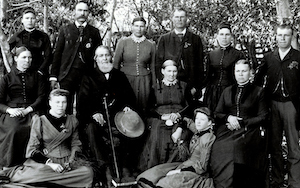Why Didn't People Smile in Old Photos?

Ever looked at an old, black-and-white photograph and wondered, “Why the long face?” You might have heard that it was because of the cameras’ long exposure times, or maybe you were told that poor dental work meant that fewer people wanted to show their teeth in old photos.
While these explanations may play a part, the main reason why people didn’t smile in old photos had more to do with culture and customs of old paintings and portraiture than it did with poor technology.
The Tradition of Not Smiling for Painted Portraits
Before photography, the main mode of preserving a family’s or person’s image was through painting portraits. It was customary for families and individuals in these commissioned, traditional portraits to have stoic, regal expressions. If they did smile, it would be only slightly.
This early custom was because wide-mouthed, toothy grins were considered inappropriate for portraiture. Even in other kinds of old paintings, a person’s wide smiles were often associated with madness, drunkenness, or otherwise informal, immature behavior.
When photography was introduced as a new way of preserving a person or family’s likeness, people continued the tradition of unsmiling expressions because it was familiar to them, and the ideals for capturing someone’s likeness had not changed.
When Did We Start Smiling in Photographs?
So what changed? How did we go from stoic expressions to saying “Cheese!” for grins? It goes back to the 1900 Brownie camera, one of the first early cameras that were accessible and affordable to the public. As photograph technology became more accessible to everyday people, photos were more spontaneous and captured candid smiles and laughter.
People began to prefer the amateur photos that captured their smiling, joyful expressions. The practice of photographing smiles crept into formal photography, and eventually it was culturally acceptable—and then encouraged—to smile in family photos and portraits.